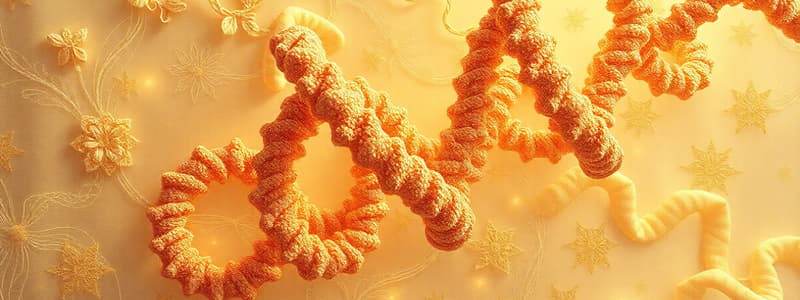Podcast
Questions and Answers
What is the significance of the sigmoid binding curve of hemoglobin in oxygen transport?
What is the significance of the sigmoid binding curve of hemoglobin in oxygen transport?
The sigmoid binding curve reflects the cooperative binding of oxygen, allowing hemoglobin to efficiently pick up oxygen in the lungs and release it in tissues.
How does 2,3-bisphosphoglycerate (2,3-BPG) influence the oxygen affinity of hemoglobin?
How does 2,3-bisphosphoglycerate (2,3-BPG) influence the oxygen affinity of hemoglobin?
2,3-BPG decreases the oxygen affinity of hemoglobin by stabilizing the T state, facilitating the release of oxygen.
Explain the transition of hemoglobin from the T state to the R state during oxygen binding.
Explain the transition of hemoglobin from the T state to the R state during oxygen binding.
Oxygen binding induces a conformational change in hemoglobin, prompting a transition from the low-affinity T state to the high-affinity R state.
What role does the half-saturation pressure of 26 torr play in understanding hemoglobin's function?
What role does the half-saturation pressure of 26 torr play in understanding hemoglobin's function?
In what way do the binding curves for hemoglobin and myoglobin differ, and what does this imply about their functions?
In what way do the binding curves for hemoglobin and myoglobin differ, and what does this imply about their functions?
What is crosslinking in biochemistry and why is it important?
What is crosslinking in biochemistry and why is it important?
Describe the significance of heptad repeats in coiled-coil proteins.
Describe the significance of heptad repeats in coiled-coil proteins.
How do disulfide bonds contribute to the physical properties of wool?
How do disulfide bonds contribute to the physical properties of wool?
Explain the difference in cross-linking between flexible and hard materials like hair and horns.
Explain the difference in cross-linking between flexible and hard materials like hair and horns.
What role do weak interactions play in the structure of α-keratin?
What role do weak interactions play in the structure of α-keratin?
Flashcards
Hemoglobin binding curve
Hemoglobin binding curve
The sigmoidal curve showing hemoglobin's oxygen binding affinity, due to the T state to R state transitions.
T state
T state
A lower-affinity state of hemoglobin, less likely to bind oxygen.
R state
R state
A higher-affinity state of hemoglobin, more likely to bind oxygen.
2,3-BPG
2,3-BPG
Signup and view all the flashcards
Oxygen binding by hemoglobin
Oxygen binding by hemoglobin
Signup and view all the flashcards
Crosslinking (biochemistry)
Crosslinking (biochemistry)
Signup and view all the flashcards
Heptad repeat
Heptad repeat
Signup and view all the flashcards
Coiled-coil protein structure
Coiled-coil protein structure
Signup and view all the flashcards
Protein Domains
Protein Domains
Signup and view all the flashcards
Weak interactions (proteins)
Weak interactions (proteins)
Signup and view all the flashcards
Study Notes
Secondary Structure
-
Alpha Helix: A coiled structure stabilized by intrachain hydrogen bonds. R groups project outward from the helix axis. Backbone CO and NH groups form hydrogen bonds, except those at the helix ends.
-
Beta Sheets: Formed by adjacent beta strands. Polypeptide strands are fully extended, in contrast to the alpha helix. Three types of beta sheets exist.
Tertiary Structure
- Heptad Repeats: Repeating residues every 7 amino acids in a coiled-coil protein. Leu residues often occur in these repeats, facilitating van der Waals interactions between helices.
Protein Domains
- Some proteins have independently folding regions (domains) connected by flexible linkers.
Quaternary Structure
-
Hemoglobin: A protein with quaternary structure, consisting of four subunits (2 alpha and 2 beta). Each subunit contains a heme group, which binds oxygen.
-
T state (deoxyhemoglobin): Low affinity for oxygen. Subunits are closely packed in a tense conformation.
-
The tetramer exists primarily in the "T" state in the absence of oxygen.*
-
R state (oxyhemoglobin): High affinity for oxygen. Subunits are more loosely packed and oxygen binding facilitates a conformational change.
-
Hemoglobin transitions to the R state upon oxygen binding and this causes increased oxygen affinity of the protein.*
-
Hemoglobin: Sequential Model: A multimeric protein's affinity changes when a ligand binds. The model suggests a transition between distinct states (T and R).
-
Bohr effect: Hemoglobin's oxygen affinity decreases with increased carbon dioxide or decreased pH. This phenomenon increases oxygen release from hemoglobin into tissues, where oxygen is needed most. Myoglobin does not experience a significant Bohr effect.
-
Fetal Hemoglobin: Fetal hemoglobin has a higher affinity for oxygen than adult hemoglobin.
-
2,3-Bisphosphoglycerate (2,3-BPG): 2,3-BPG stabilizes the T state of hemoglobin, promoting oxygen release. 2,3-BPG binds to a pocket in the hemoglobin tetramer, which only exists in the T state.
-
Mutations: Mutations in hemoglobin genes can lead to diseases like sickle cell anemia.
Studying That Suits You
Use AI to generate personalized quizzes and flashcards to suit your learning preferences.




